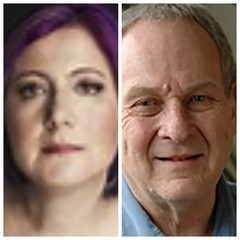|
Back
New York
BargeMusic
06/17/2022 -
Lewis Spratlan: Invasion – Wonderer – Three Sonatas – Six Rags – Piano Suite No. 1
Nadi Shpachenko (Piano), Pat Posey (Saxophone), Aija Mattson-Jovel (Horn), Phil Keen (Trombone), Yuri Inoo (Percussion), Joti Rockwell (Mandolin), Anthony Parnther (Conductor)

N. Shpachenko/L. Spratlan (© Courtesy of the Artists)
“When the flag is unfurled, all reason is in the trumpet.”
Ukrainian proverb
The rare combination of poetry and athleticism by Nadi Shpachenko was on full display last night, as the executant of equally athletic compositions by Lewis Spratlan. And while the evening was over-saturated by notes and rhythms and cataclysms and emotions by the end of this recital, the saturation was generated by metaphorical extra helpings of Beluga Caviar in every conceivable incarnation.
Ms. Shpachenko resides on the West Coast, yet she has been a paragon of execution for virtually every American composer from Elliott Carter to the late (alas) George Crumb to last night’s Lewis Spratlan. And no wonder. It isn’t her incredible pianism, her endless gymnastics; instead it was her clarity, the quantum attention to every change of metre in every measure. The performance of muscular piano geniuses is hardly rare, and their displays can always dazzle us. Ms. Shpachenko takes another route, that of sprinting down dozens of simultaneous tangly paths and allowing us to see every flower, tree, insect along the way.
Previously, I had heard only one work by Lewis Spratlan, his Bangladesh, a paean to the building of Dhaka’s National Assembly. It was a well-crafted architecture, including an ersatz Bengali tune, and part of a recital by Ms. Shpachenko based on an eclectic share of geographical places.
Here, Mr. Spratlan had the whole evening to himself. The results were not terribly cerebral (only a rare venture into atonality), where tunes were transformed, parodied, multi-stylized, but always with a deft compositional hand which rivalled Ms. Shpachenko’s own two hands.
For his opening work, he described–verbally–his Invasion as “Agggh”. The Russian invasion of Ms. Shpachenko’s native Ukraine could only be depicted with that word. Musically, it could have resembled Goya’s war pictures or Picasso’s Guernica. But the instruments themselves (in a recording played for the audience) offered a picture of frightening tragedy.
It started yes, with a percussive bang. But the medley of improbable instruments–horn, trombone, mandolin, sax and of course Ms. Shpachenko’s piano–gave a picture of war at its most warlike. Mr. Spratlan was never averse to interject a folk melody or two, yet they were eradicated by the sounds of battle. It was a stunning opening.
Invasion was composed three months ago. Ms. Shpachenko’s performance took over Mr. Spratlan back to his Wonderer. That work, written for Jonathan Biss, was long, gnarly, complicated, difficult and frankly losing interest as it went on. Like Invasion, it started with a bang, this time in the treble. And continued with footsteps louder and louder, the occasional waltz and motives continued and discontinued. Mr. Spratlan said it could be like the refugees of the Ukrainian war, but this music written in 2005, had little human tragedy.
Two other works were shorter, fun, faintly derivative (the Three Sonatas from Scarlatti, the Suite with a Capriccio that defied digits).
I say “derived”, yet that is not the right word. Like Josquin des Prez, like Shchedrin and like Charles Ives, Mr. Spratlan was always ready to either quote from or mirror other styles, other music. Using Scott Joplin as his foundation for Six Rags was genius. Each of them had a geographical place named in the New England mountains. Yet that was a personal inspiration. The results were purely original.
Yes, he used Joplin-style rags within each of the six pieces. They could be blatant–and played with dynamic impetus by Ms. Shpachenko–or hidden amongst a forest of intervals. My own absolute favorite was supposedly Mahoosuc Notch Rag. But I prefer to call it Mussorgsky’s Inebriated Rag.
The picture was evident. Loud rambunctious bass chords struck out, followed by happy rag tunes. In my imagination I saw Mussorgsky barely waking from a drunken afternoon, grabbing and playing a first draft of Pictures at an Exhibition, falling asleep, waking and finding a Scott Joplin rag, sleeping again and going back to his own music. Repeat and repeat!!
Ms. Shpachenko didn’t have to emphasize the ironies in all six Rags. They sung for themselves, were written with elation, and played last night with both brunt and beauty.
Harry Rolnick
|